Mayo Clinic
Mayo Clinic is an American nonprofit academic medical center currently based in three major locations: Rochester, Minnesota; Jacksonville, Florida; and Scottsdale, Arizona, focused on integrated patient care, education, and research.[6] It employs over 4,500 physicians and scientists, along with another 58,400 administrative and allied health staff.[7][8] The practice specializes in treating difficult cases through tertiary care and destination medicine. It is home to the top-ten ranked Mayo Clinic Alix School of Medicine in addition to many of the highest regarded residency education programs in the United States.[9][10][11] It spends over $660 million a year on research and has more than 3,000 full-time research personnel.[12][13]
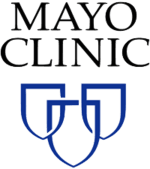 | |
| Nonprofit 501(c)(3) organization, 509(a)(2) public charity | |
| Industry | Health care |
| Founded | January 27, 1864 Rochester, Minnesota, USA |
| Founders | William Worrall Mayo William James Mayo Charles Horace Mayo Augustus Stinchfield Christopher Graham Henry Stanley Plummer Melvin Millet E. Star Judd Donald Balfour |
| Headquarters | , |
Area served | |
Key people |
|
| Revenue | US$12.603 billion (2018)[3]:13 |
| Total assets | US$17.305 billion (2018)[4]:13 |
Number of employees | 63,000[5]:3 |
| Divisions |
|
| Website | www |
William Worrall Mayo settled his family in Rochester in 1864 and opened a sole proprietorship medical practice that evolved under his sons, Will and Charlie Mayo, along with practice partners Drs. Stinchfield, Graham, Henry Plummer, Millet, Judd, and Donald Balfour, into Mayo Clinic. Today, in addition to its flagship hospital in Rochester, Mayo Clinic has major campuses in Arizona[14] and in Florida.[15] The Mayo Clinic Health System also operates affiliated facilities throughout Minnesota, Wisconsin, and Iowa.[16]
Mayo Clinic is ranked number 1 in the United States for 2019-20 U.S. News & World Report Best Hospitals Honor Roll,[17] maintaining a position at or near the top for more than 27 years.[18] It has been on the list of "100 Best Companies to Work For" published by Fortune magazine for fourteen consecutive years, and has continued to achieve this ranking through 2017.[19][20] Drawing in patients from around the globe, Mayo Clinic performs near the highest number of transplants in the country, including both solid organ and hematologic transplantation.
Corporate affairs
Mayo Clinic is a nonprofit hospital system with campuses in Rochester, Minnesota, Scottsdale and Phoenix, Arizona, and Jacksonville, Florida.[21][22] Mayo Clinic employs 63,000 people, including more than 4,500 physicians and scientists and 58,400 administrative and allied health staff, as of 2018.[23][24] Of those, approximately 34,000 are based in Rochester.[25] In addition, Mayo Clinic partially owns and operates the Mayo Clinic Health System, which consists of more than 70 hospitals and clinics across Minnesota, Iowa, and Wisconsin.[26] Mayo Clinic also operates the Mayo Clinic College of Medicine and Science, a nonprofit college dedicated to training medical and allied health professionals at Mayo Hospitals in Minnesota, Arizona, and Florida.[27]
The clinic created an independent business subsidiary in London in partnership with Oxford University Clinic, a collaboration between the University of Oxford and Oxford University Hospitals NHS Foundation Trust to operate a clinic starting in 2019.[28] The clinic, in the Harley Street Medical Area, will focus on preventative healthcare, with magnetic resonance imaging and CT scan technology and open in the summer of 2019.[29]
Mayo Clinic is led by president and CEO Gianrico Farrugia, M.D.[30] John H. Noseworthy, M.D. retired as president and CEO in December 2018; his predecessor, Denis A. Cortese, M.D. retired in November 2009.[31] Samuel A. DiPiazza, Jr., retired CEO of PricewaterhouseCoopers, is chairman of Mayo Clinic's governing board of trustees.[32]
Core operations
Patient care
In 2018, more than 1.2 million different patients from all 50 states and 138 countries were seen at one of the Mayo Clinic facilities.[8] Mayo Clinic offers highly specialized medical care, and a large portion of the patient population are referrals from smaller clinics and hospitals across the upper Midwest and the United States. Mayo Clinic physicians are paid a fixed salary, which is not linked to patient volume (relative value units) or income from fee-for-service payments.[33][34][35] This practice is thought to decrease the monetary motivation to see patients in excessive numbers and increase the incentive to spend more time with individuals.[33]
Research
Mayo Clinic researchers contribute to the understanding of disease processes, best clinical practices, and translation of findings from the laboratory to the clinical practice. As of 2018, research personnel included 254 full-time scientific faculty, 766 physicians actively involved in research, and 4,027 full-time research personnel. In 2018, there were 3,067 new human research studies approved by the institutional review board and 12,760 ongoing human research studies. These research initiatives led to 9,275 research publications and review articles in peer-reviewed journals.[8] In recent years, 100% of Mayo Clinic’s internal medicine residents across the three campuses have published research during their tenure. In 2020, Mayo Clinic shut down a prominent lab working on federally funded research led by Dr. Jan van Deursen, who was accused of bullying[36].
Education
The Mayo Clinic College of Medicine and Science (MCCMS), established in 1915, offers educational programs embedded in Mayo Clinic's clinical practice and biomedical research activities.[37] MCCMS consists of five accredited schools, including the M.D. degree-granting Mayo Clinic Alix School of Medicine as well as the master's and Ph.D. degree-granting Mayo Clinic Graduate School of Biomedical Sciences. The Mayo Clinic School of Health Sciences offers training for about 60 health sciences career fields.[8] The Mayo Clinic School of Graduate Medical Education runs over 300 residences and fellowships in all medical and surgical specialties. The Mayo Clinic School of Continuous Professional Development delivers continuing education courses aimed at practicing medical professionals.
History
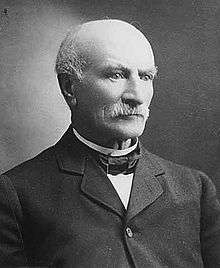
Early years
Mayo Clinic originates with the medical practice of William Worrall Mayo, M.D., (1819–1911).[38]:5 Born near Manchester, England, he was mentored by the eminent British scientist John Dalton[38]:11–13 and immigrated to the United States in 1846.[39]:29 He worked his way west, earning two medical degrees at a time when formal education for physicians was limited.[38]:20–21, 31 Dr. Mayo settled in Indiana, and he married Louise Abigail Wright in 1851.[38]:25 They moved to Minnesota Territory in 1854, seeking a more healthful climate.[38]:32–33 The family relocated within Minnesota several times until Dr. Mayo’s appointment as an examining surgeon for the Union Army military draft board during the American Civil War brought them to Rochester.[38]:78 On January 27, 1864, Dr. Mayo advertised in the Rochester City Post the opening of a private medical practice "over the Union Drug Store on Third Street" with "all calls answered by day or night".[40]
Both of Dr. W.W. Mayo's sons, William James Mayo (1861–1939) and Charles Horace Mayo (1865–1939), who became known as Dr. Will and Dr. Charlie, grew up in Rochester and attended medical school. William graduated in 1883 and joined his father's practice, with Charles joining in 1888.[41][42] On August 21, 1883, a tornado struck Rochester, causing at least 37 deaths and over 200 injuries.[43] One-third of the town was destroyed, but the Mayo family escaped serious harm. Relief efforts began immediately in a variety of makeshift facilities. Dr. Mayo was placed in charge of organizing medical care for the wounded survivors. Needing nurses, he reached out to Mother Alfred Moes, the founder of the Sisters of Saint Francis of Rochester, Minnesota (a teaching order).[38]:244
After the crisis subsided, Mother Alfred approached Dr. Mayo with a proposal: The Sisters of St. Francis would raise the funds to build a hospital in Rochester if he and his sons would provide the medical and surgical care.[38]:246–247 The agreement was made over a handshake.[39]:51 On September 30, 1889, Saint Marys Hospital was opened by the Sisters with the three Mayo physicians on staff.[39]:11–22

Group practice
The growing specialization of medicine and the expanding use of railroads, automobiles, and mass communications provided context for what Mayo Clinic calls its most significant and enduring contribution to the medical field: the content of integrated multispecialty practice.[38]:481–485, 497[39]:134[44]:28–30
Starting in the 1890s, the Mayo brothers welcomed other physicians to join them. Dr. W.W. Mayo’s solo practice had evolved into a family practice with his sons' participation and now became a group practice with colleagues whose professional skills and ethos of teamwork complemented those of the Mayo brothers.[38]:359 Mayo Clinic's first partners were physicians Drs. Augustus W. Stinchfield,[45] Christopher Graham,[46] Melvin C. Millet,[47] Henry Plummer, [48] E. Star Judd,[49] and Donald Balfour.[50]
Preeminent among the early physicians who joined the practice was Henry Plummer, M.D. A specialist in thyroid disease, he made milestone contributions to the treatment of goiter.[38]:632, 634–636 In terms of organizational development, he collaborated with the Mayo brothers in coordinating the introduction of specialties that expanded the scope of the Mayo practice beyond its origins in surgery.[44]:19 A polymath whose interests included architecture, engineering, and art, Dr. Plummer also created many of the systems and procedures that remain central to Mayo Clinic today, such as the integrated "dossier" medical record.[44]:37 In fact, Dr. Will said that hiring Dr. Plummer was the best day’s work he ever did.[38]:390
Growth and national expansion
By virtue of their surgical skills and efficient management, the Mayo brothers were financially successful and professionally prominent. They both served as president of the American Medical Association and achieved international recognition as surgeons.[44]:23–25 In 1919, the brothers and their wives donated the assets of the medical practice including land, buildings, and equipment, as well as the majority of their life savings, to transform the private partnership into a not-for-profit organization dedicated to an integrated mission of patient care, medical education, and medical research.[39]:105[51][52][53]
Following World War II, Mayo Clinic continued to expand in Rochester, Minnesota. The 1980s initiated transformative changes that set the course for the modern Mayo Clinic.[44]:480–481 An early adaptor of the Internet,[44]:502–504 Mayo Clinic has been recognized for its online communications to patients, members of the public and medical professionals.[39]:131
In 1986, Mayo Clinic formally united with Saint Marys Hospital and Rochester Methodist Hospital.[54] Following a trip to Jacksonville in 1979 the Mayo brothers expanded the Mayo Clinic to Jacksonville, Florida,[55] Sitting on the now 300+ acre campus is Lake Mayo which the brothers attributed to their choice of location. This was followed by expansion to Scottsdale, Arizona, in 1987;[56] the Phoenix, Arizona, campus opened in 1998.[56] In 1992, Mayo Clinic Health System began as a network of community-based medical services in Minnesota, Iowa, and Wisconsin.[57] In 2011, Mayo Clinic launched the Mayo Clinic Care Network, a collection of facilities with access to Mayo Clinic protocols and experts.[58]
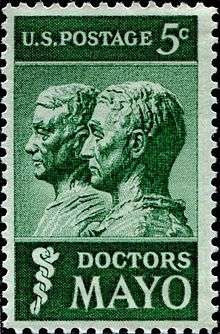
Contributions to medicine and science
In the early 20th century, Dr. Henry Plummer developed Mayo Clinic's multi-specialty group practice model and an integrated medical record system.[59] Plummer's system allowed doctors to better share patient information with one another.[59] Prior to Plummer's system, doctors worked in solo practice and shared patient information when necessary either verbally or by letter.[59] Plummer also helped design and fabricate building systems innovations, such as steam sterilization rooms, metal surgical tools and equipment, pneumatic tube system, and knee operated sinks.[60][61] In 1905, Mayo Clinic advanced a technique of using frozen tissue during surgery to determine if a patient had cancer while the patient was still in the operating room.[62][63] Mayo Clinic offered the first graduate medical education program in 1915 and the first nonprofit practice aligned with medical education and research.[63] In the 1920s, Dr. Albert Compton Broders of the Mayo Clinic created the first index to grade tumors.[64] Mayo Clinic opened the first hospital-based blood bank in Rochester in 1935.[65] Early in Mayo Clinic's history, the hospital designed the one-legged mobile instrument stand known as the Mayo stand.[66]
In the 1930s, Mayo Clinic Drs. Walter M. Boothby, Randolph Lovelace, and Arthur Bulbulian developed a high-altitude mask for oxygen therapy that became known as the BLB flight mask.[67]
During World War II, the U.S. Army tasked Mayo Clinic with finding a solution for pilots who were dying after suffering blackouts. Mayo Clinic hired a team of doctors to research and define the specific physiologic effects causing blackout and unconsciousness during high G forces.[68] Physiologists Drs. Earl H. Wood, Edward Baldes, Charles Code, and Edward Lambert developed the G-suit with air bladders that prevented blood from pooling in pilots' legs.[68] The suit was worn by U.S. pilots toward the end of World War II.[69][70][71]
Two Mayo Clinic doctors were among three people awarded the Nobel Prize in medicine in 1950 for the discovery of cortisone.[72] Professor Edward C. Kendall, PhD, and Dr. Philip S. Hench of Mayo Clinic were jointly awarded the Nobel Prize in medicine alongside Dr. Tadeus Reichstein, a Swiss chemist who conducted independent research, for the discovery.[72] They separated and identified compounds from the adrenal cortex that produced cortisone and hydrocortisone.[73] Later in the decade, Mayo Clinic began using and refining the Gibbon heart-lung machine in cardiac surgery. It is now known as the Mayo-Gibbon heart-lung machine.[74]
Mayo Clinic Drs. Edward Howard Lambert, Lealdes (Lee) McKendree Eaton, and Edward Douglas Rooke were the first physicians to substantially describe the clinic and electrophysiological findings of what is known as Lambert–Eaton myasthenic syndrome in 1956.[75][76] In 1972, the clustering of LEMS with other autoimmune diseases led to the hypothesis that it was caused by autoimmunity.[77]
In 1969, Mayo Clinic doctors performed the first Food and Drug Administration-approved hip replacement in the United States.[78] In 1973, Mayo Clinic bought the first CT scanner in the U.S.[79]
Mayo Clinic and Roche Molecular Biochemicals developed a rapid DNA test in 2001 to detect anthrax in humans and in the environment.[80]
The Mayo Clinic Center for Innovation, was established in 2008 and has since worked on over 270 projects.[81][82]
In 2013, Mayo Clinic specialists in regenerative-medicine begin the "first-in-human study" whereby patient cells are used to attempt to heal heart damage.[65]
After several years using Apple Inc.'s Macintosh computers and mobile devices for patient care and test results, Mayo partnered with Apple in 2014 to develop the Apple Health and HealthKit apps to serve as a central location for personal health information.[83] Mayo Clinic and Delos Living launched the Well Living Lab in September 2015. This research facility is designed to simulate real-world, non-hospital environments to allow Mayo Clinic researchers to study the interaction between indoor spaces and human health.[84]
Architecture and art collection
As the practice grew in the 20th century, it required additional space. Saint Marys Hospital underwent frequent expansion. Rochester business leader John Kahler built innovative hotel-hospital facilities that served Mayo Clinic patients.[38]:501–502 In 1914, Mayo Clinic opened the world’s first building expressly designed for multispecialty group practice, known as the 1914 "red brick" building.[85][38]:544 It facilitated ease of movement for patients and staff among specialty areas, brought research and education functions into proximity with clinical practice, and patient amenities.[38]:544[44]:38–41 This approach was replicated and enhanced with the adjoining 1928 Mayo Clinic building, later named for Dr. Plummer,[44]:77–80 its principal designer, which is listed on the National Register of Historic Places.[38]:697–698[86][87] The Plummer Building features bronze entry doors designed by artist Charles Brioschi. Each 16-foot high, 5.25-inch thick door weighs 4,000 pounds and features ornamental panels. The doors are closed to memorialize important historical events and influential people, such as the deaths of the Mayo brothers, the assassination of President John F. Kennedy, and the victims of September 11, 2001 terrorist attacks.[88] The 1914 "red brick" building, a National Historic Landmark, was demolished by Mayo Clinic in the 1980s to make way for the Siebens Building (completed in 1989).[85][89] Mayo Clinic's campus has undergone expansion over the years.[90]
Other notable Mayo Clinic buildings include the Mayo Building (Rochester, Minnesota) (construction completed in 1955), Guggenheim Building (1974), Gonda Building (2001), and Opus Imaging Research Building (2007).
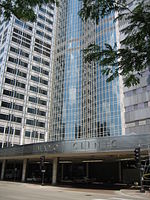 Gonda Building entrance
Gonda Building entrance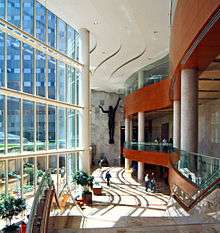 Gonda Building atrium
Gonda Building atrium Patient cafeteria dome
Patient cafeteria dome- Opus Imaging Research Building
- Guggenheim Building
Mayo Clinic's humanities program was founded on the belief that the arts and healing are linked.[91] Over the decades, Mayo Clinic has established an extensive art collection, including these works on display across all campuses:
- "Endangered Species" by Andy Warhol
- "John D'Aire" by Auguste Rodin
- "Fish" by Alexander Calder
- "Man and Freedom" by Ivan Mestrovic
- "Untitled" by Dale Chihuly
- "Four Houses" by Jennifer Bartlett
- "The Archer" by Joan Miro
- "My Brother and I" by Tuck Langland
- "Constellation Earth" by Paul Granlund
Educational programs
The first medical educational programs at Mayo Clinic were developed in 1915 with the assistance of the University of Minnesota.[92][53] Mayo Clinic School of Graduate Medical Education and the Mayo Foundation for Medical Education and Research were established in 1915.[93][94] MFMER was established as a department of the University of Minnesota with a $1.5 million donation to offer graduate programs at the Mayo Clinic in Rochester.[95] The Mayo Clinic School of Graduate Medical Education is now part of the Mayo Clinic College of Medicine and Science, which is divided into five schools.[96][97] Those schools include Mayo Clinic Alix School of Medicine, Mayo Clinic School of Health Sciences, Mayo Clinic School of Continuous Professional Development, and Mayo Clinic Graduate School of Biomedical Sciences.[39]:131
In 2011, the foundation that oversees the Mayo Clinic went before the Supreme Court to argue that medical residents should remain exempt from Social Security deductions. In Mayo Foundation v. United States the court sided with the Social Security Administration and required FICA to be deducted going forward.[98]
Current practice
Mayo Clinic rules mandate that its CEOs must be physicians and come from within Mayo Clinic.[99] John H. Noseworthy, M.D., served as president and CEO from 2009-2019.[31] Under his leadership, Mayo Clinic was reorganized into a single operating company with a unified strategy and business plan, which helped the system expand.[30] This included the launch of the Destination Medical Center, a 20-year economic growth plan in Rochester.[30] During this time, annual revenue reached nearly $12 billion, and Mayo Clinic added 7,200 employees.[24]
In 2018, Mayo Clinic announced that Gianrico Farrugia, M.D., a Mayo Clinic physician for more than 30 years, would replace Dr. Noseworthy as CEO.[100] Dr. Farrugia had served as CEO of Mayo Clinic in Florida since 2015.[30] The replacement adhered to Mayo Clinic's tradition of leadership changes, where a new president or CEO is named every seven to 10 years.[101] By 2018, Mayo Clinic doctors saw approximately 1.3 million patients annually.[100]
Innovation
Mayo Clinic remains at the forefront of medical innovation leading hundreds of clinical trials and offering groundbreaking therapies, such as CAR-T and proton therapies. They are currently one of the leading research centers for the COVID-19 epidemic and were one of the first institutions offering plasma exchange for this patient population.
Mayo Clinic has adopted more than 15,000 mobile devices from Apple for patient care, including the iPad, iPad Mini, and iPhone. Mayo Clinic then created an app for these devices called Synthesis Mobile, which integrated hundreds of their health systems. For Mayo Clinic Care Network members, more apps were created to help patients see their medical records or ask clinicians for assistance.[102] In 2014, Mayo Clinic was developing an app for Apple's HealthKit to help users maintain healthy lifestyles and warn of certain health signs that need attention.[103]
Mayo Clinic, in collaboration with real estate firm Delos Living, launched the Well Living Lab in September 2015. This research facility is designed to simulate real-world, non-hospital environments to allow Mayo Clinic researchers to study the interaction between indoor spaces and human health.[84]
The Mayo Clinic Center for Innovation, established in 2008, was one of the pioneers of innovation in healthcare. It has since worked on over 270 projects and is often looked to as a role model for using design in healthcare.[104]
In March 2018, Mayo Clinic and Mytonomy, a healthcare education system company, partnered to provide video content for cancer patients. The video content is used to address important questions and answers and designed to aid in the decision-making process between patient and doctor.[105]
In September 2019, Mayo Clinic entered into a strategic partnership with Google for health care innovation and cloud computing, and Google planned to open its facility in Rochester, Minnesota for Mayo Clinic[106]
In January 2020, Mayo Clinic and NTT Venture Capital joined a $60 million financing for biomedical software startup nference.[107]
Rankings
In 2016-17, Mayo Clinic, Rochester, was ranked as the #1 overall hospital in the United States by U.S. News & World Report. A total of almost 5,000 hospitals were considered and ranked in 16 specialties from cancer and heart disease to respiratory disorders and urology; 153 (just over 3 percent of the total) were ranked in at least one of the 16 specialties. Of the 153 hospitals that are ranked in one or more specialties, 20 qualified for the Honor Roll by earning high scores in at least six specialties. Mayo Clinic, Rochester, was ranked in the top 10 in all but one of 16 specialties, in the top 4 in 13 specialties, and was the #1 ranked hospital in 8 of the 12 data-driven specialties. This year U.S. News expanded their common procedures and conditions list to 9 individual measures, and Mayo was one of fewer than 70 hospitals to score High Performing in every category.[108] Additionally, Mayo was the only hospital on the 2016-2017 honor roll to also receive 5 stars from CMS.[109] Every Mayo Clinic hospital received an "A" safety rating from Leapfrog in its April 2017 report.[110] In 2019-20, Mayo Clinic, Rochester, was ranked again as the #1 overall hospital in the United States by U.S. News & World Report.
|
Ranked 1st
|
Ranked 2nd
|
Ranked 3rd - 6th
|
High-Performing
|
See also
References
- Richert, Catharine (August 10, 2018). "Mayo Clinic names Farrugia as new CEO". Minnesota Public Radio.
- Snowbeck, Christopher (August 11, 2018). "New Mayo Clinic CEO most recently led its Florida operation". Star Tribune.
- "Mayo Clinic Year End 2018 Connsolidated Short Form" (PDF). Mayo Clinic. 2018. Retrieved December 31, 2018.
- "Mayo Clinic Year End 2018 Connsolidated Short Form" (PDF). Mayo Clinic. 2018. Retrieved December 31, 2018.
- "An Inside Look at the Mayo Clinic" (PDF). Mayo Clinic. 2017. Retrieved January 30, 2018.
- "About Us - Mayo Clinic Value Statements". Mayo Clinic.
- Mayo Clinic Website. . Accessed March 11, 2013.
- "Mayo Clinic Facts". December 2018. Retrieved April 28, 2020.
- "Mayo Clinic School of Medicine - Best Medical School". U.S. News & World Report. Retrieved January 14, 2019.
- "Mayo Clinic College of Medicine and Science (Rochester)". Doximity Residency Navigator. Doximity. Retrieved February 4, 2019.
- Castellucci, Maria (July 21, 2018). "Medical students play a high-stakes game to match into residency programs". Modern Healthcare. Retrieved February 4, 2019.
- "About Mayo Clinic Research".
- McKinney, Matt (June 8, 2016). "Mayo Clinic unveils plans for expanded research space". Star Tribune. Retrieved August 25, 2016.
- "Mayo Clinic's Campus in Arizona". Mayo Clinic. Retrieved October 21, 2018.
- Stephanie Innes (September 5, 2018). "Mayo Clinic to nearly double size of Phoenix campus in five-year, $648 million project". The Arizona Republic. Retrieved October 21, 2018.
- "Locations - Mayo Clinic Health System". Mayo Clinic.
- "U.S. News & World Report Hospital Rankings & Ratings". Retrieved August 28, 2009.
- "Top American Hospitals – US News Best Hospitals". U.S. News & World Report. Retrieved September 4, 2010.
- "100 Best Companies to Work For 2011: Mayo Clinic". Fortune. February 7, 2011. Retrieved January 20, 2011.
- "100 Best Companies to Work For 2017". Fortune. Retrieved May 16, 2017.
- Stubbe, Glen (January 5, 2014). "John Noseworthy, Mayo Clinic". Star Tribune. Retrieved October 23, 2018.
- DePass, Dee (September 6, 2018). "Mayo Clinic will spend about $800 million to expand in Arizona and Florida". Star Tribune. Retrieved October 23, 2018.
- "52 great health systems to know". Becker's Hospital Review. June 19, 2018. Retrieved October 2, 2018.
- Snowbeck, Christopher (February 20, 2018). "Mayo Clinic's CEO to retire at year's end". Star Tribune. Retrieved October 23, 2018.
- Boese, Brett (October 3, 2017). "Mayo, Oxford transatlantic partnership". The Post-Bulletin. Retrieved October 2, 2018.
- "System aims to reach 200 million patients by 2020". Advisory.com. December 10, 2014. Retrieved October 2, 2018.
- "Mayo Clinic School of Medicine". U.S. News & World Report. 2018. Retrieved October 2, 2018.
- "Mayo Clinic, Oxford to collaborate on research and innovation". Healthcare IT news. October 5, 2017. Retrieved December 23, 2017.
- "US hospital group takes first step in partnership with Oxford University Clinic". Building Better Healthcare. May 20, 2019. Retrieved July 8, 2019.
- Karnowski, Steve (August 10, 2018). "Mayo Clinic names head of Florida campus as new CEO". ABC News. Retrieved October 23, 2018.
- Newmarker, Chris (May 8, 2009). "Noseworthy Named New Mayo Clinic CEO". Minneapolis-St. Paul Business Journal. Retrieved October 5, 2015.
- Kiger, Jeff (November 13, 2017). "Mayo Trustee board re-elects chairman". The Post Bulletin. Retrieved October 23, 2018.
- Underwood, Anne (September 23, 2009). "A new way to pay physicians". The New York Times. Retrieved January 30, 2018.
- MacGillis, Alex; Stein, Rob (September 20, 2009). "Is the Mayo Clinic a model or a mirage? Jury is still out". The Washington Post. Retrieved January 30, 2018.
- Olson, Jeremy (April 23, 2015). "Mayo faces new price of success". Star Tribune. Retrieved January 30, 2018.
- "Top researcher accused of bullying as Mayo closes his lab".
- "Mayo Clinic College of Medicine and Science". Mayo Clinic.
- Clapesattle, Helen (1941). The Doctors Mayo. The University of Minnesota Press.
- Blistein, David; Burns, Ken (2018). The Mayo Clinic: Faith—Hope—Science. Florentine Books. ISBN 978-1948122290.
- Furst, Jay (2014). "Fight for the Union, 1864: Hope grows for war's end". Post-Bulletin (Rochester, Minn.), Sept. 6, 2014.
- Schlup, Leonard; Ryan, James G. (2003). Historical dictionary of the Gilded Age. Armonk, N.Y.: M.E. Sharpe. p. 299. ISBN 9780765621061.
- "Mayo, Charles Horace (1865 - 1939)". Royal College of Surgeons. Retrieved August 25, 2016.
- "The Rochester, MN Tornado of 1883". National Weather Service. Retrieved October 5, 2015.
- Fye, W. Bruce (2015). Caring for the Heart: Mayo Clinic and the Rise of Specialization. Oxford University Press.
- Lennon, Troy (June 29, 2011). "A medical institution of honourable beginnings". The Daily Telegraph (Sydney). Retrieved July 26, 2019.
- Nelson, Clark W. (June 1993). "Historical Profiles of Mayo". Mayo Clinic Proceedings. 68 (6): 522. doi:10.1016/S0025-6196(12)60366-8.
- Nelson, Clark W. (July 1993). "Historical Profiles of Mayo". Mayo Clinic Proceedings. 68 (7): 626. doi:10.1016/S0025-6196(12)60596-5.
- Nelson, Clark W. (August 1993). "Historical Profiles of Mayo". Mayo Clinic Proceedings. 68 (8): 730. doi:10.1016/S0025-6196(12)60627-2.
- Nelson, Clark W. (September 1993). "Historical Profiles of Mayo". Mayo Clinic Proceedings. 68 (9): 834. doi:10.1016/S0025-6196(12)60689-2.
- "In Memoriam". Gastroenterology. 46 (2): 207. June 1993. doi:10.1016/S0016-5085(64)80060-3.
- Berry, Leonard; Seltman, Kent (January 1, 2014). "Chapter 31: The Mayo Clinic Way: A Story of Cultural Strength and Sustainability". In Schneider, Benjamin; Barbera, Karen (eds.). The Oxford Handbook of Organizational Climate and Culture. Oxford University Press. pp. 611–612. ISBN 9780199860715.
the brothers created Mayo Properties Association in 1919, transforming Mayo clinic from a for-profit, privately held company to a not-for-profit organization.
- Danilov, Victor (September 26, 2013). "Medical Innovators". Famous Americans: A Directory of Museums, Historic Sites, and Memorials (1 ed.). Scarecrow Press. p. 135. ISBN 9780810891852.
Dr. Charles Horace Mayo was born after a move to Rochester - where the three Mayo doctors and four other physicians later founded the Mayo Clinic, which became a not-for-profit medical facility in 1919
- Rogers, Karen (January 1, 2011). Medicine and Healers Through History. Britannica Educational Publishing. p. 200. ISBN 9781615304059.
In 1919 the Mayo Brothers transferred property and capital to the Mayo Properties Association, later called the Mayo Foundation, a charitable and education corporation having a perpetual charter. ...In 1915 the Mayo Brothers gave $1.5 million to the University of Minnesota to establish the Mayo Foundation for Medical Education and Research at Rochester in connection with the clinic. The foundation, which is part of the University of Minnesota Graduate School, offers graduate training in medicine and related subjects.
- "Mayo Clinic timeline". The Post-Bulletin. May 9, 2014. Retrieved October 2, 2018.
- Snowbeck, Christopher (May 9, 2016). "Mayo Clinic in race for Florida patients". The Star Tribune. Retrieved November 19, 2018.
- "Mayo Clinic Hospital in Phoenix among top 20 in national ranking". Arizona Republic. August 8, 2017. Retrieved November 19, 2018.
- "Mayo Clinic". U.S. News & World Report. 2018. Retrieved November 20, 2018.
- Hansel, Jeff (December 6, 2013). "Mayo Clinic Care Network reaches into California". The Post-Bulletin. Retrieved April 26, 2019.
- Snowbeck, Christopher (September 15, 2017). "Mayo rolls out big health record project". Star Tribune. Retrieved October 4, 2018.
- Campbell, Cal (August 28, 2017). "Little known characters in America: Dr. Henry Stanley Plummer". Journal Gazette/Times-Courier. Retrieved October 2, 2018.
- Grayson, Katharine (April 25, 2016). "Mayo Clinic names $1B tech project after big-thinking doc". Minneapolis/St. Paul Business Journal. Retrieved October 2, 2018.
- Hansel, Jeff (July 5, 2014). "A century-old technique prevents extra tumor surgeries at Mayo". The Post Bulletin. Retrieved October 4, 2018.
- "10 Mayo Clinic innovations you probably don't know about". Becker's Hospital Review. September 12, 2014. Retrieved October 4, 2018.
- Wright, James R. (2012). "Albert C. Broders' Paradigm Shifts Involving the Prognostication and Definition of Cancer". Archives of Pathology and Laboratory Medicine. 136 (11): 1437. ISSN 0003-9985. Retrieved October 4, 2018.
- "History of Mayo Clinic". The Post-Bulletin. September 27, 2013. Retrieved October 4, 2018.
- Meals, Clifton; Wang, Jeffrey (June 2010). "Origins of Eponymous Orthopaedic Equipment". Clinic Orthopaedics and Related Research. 468 (6): 1682–1692. doi:10.1007/s11999-009-1221-z. Retrieved July 24, 2019.
- Dill, D.B. (October 29, 1954). "Walter M. Boothby, Pioneer in Aviation Medicine". Science. 120 (3122): 688. doi:10.1126/science.120.3122.688. Retrieved July 17, 2019.
- Hansel, Jeff (March 21, 2009). "Remembrance -- Wood was G-suit inventor, Mayo doctor". The Post Bulletin. Retrieved July 17, 2019.
- WOOD EH, LAMBERT EH. The effect of anti-blackout suits on blood pressure changes produced on the human centrifuge. Fed Proc. 1946;5(1 Pt 2):115. PubMed PMID 21066536.
- Wood EH. Contributions of aeromedical research to flight and biomedical science. Aviat Space Environ Med. 1986 Oct;57(10 Pt 2):A13-23. Erratum in: Aviat Space Environ Med 1987 Jul;58(7):706. PubMed PMID 3778400.
- Wood EH. Development of methods for prevention of acceleration induced blackout and unconsciousness in World War II fighter pilots. Limitations: present and future. Physiologist. 1987 Feb;30(1 Suppl):S27-30. PubMed PMID 3550843.
- Hilchey, Tim (August 6, 1996). "Tadeus Reichstein, 99, Dies; Won Nobel for Cortisone Work". The New York Times. Retrieved October 4, 2018.
- "Dr. Kendall Dies; Nobel Laureate". The New York Times. May 5, 1972. Retrieved November 19, 2018.
- "Mayo-Gibbon Heart-Lung Machine". The National Museum of American History. Smithsonian. Retrieved October 4, 2018.
- Lambert-Eaton-Rooke syndrome at Who Named It?
- Lambert EH, Eaton LM, Rooke ED (1956). "Defect of neuromuscular conduction associated with malignant neoplasms". Am. J. Physiol. 187: 612–613.
- Gutmann L, Crosby TW, Takamori M, Martin JD (September 1972). "The Eaton–Lambert syndrome and autoimmune disorders". Am. J. Med. 53 (3): 354–6. doi:10.1016/0002-9343(72)90179-9. PMID 4115499.
- Hansel, Jeff (March 10, 2007). "Mayo is a hip place for surgery". The Post-Bulletin. Retrieved October 4, 2018.
- Zarembo, Alan (September 7, 2008). "The high cost of precision". Los Angeles Times. Retrieved October 4, 2018.
- "Mayo Clinic touts new test to detect anthrax quickly". CNN. November 5, 2001. Retrieved October 4, 2018.
- Bhatti, Yasser; del Castillo, Jacqueline; Olson, Kristian; Darzi, Ara (March 2, 2018). "Putting Humans at the Center of Health Care Innovation". Harvard Business Review. Retrieved October 2, 2018.
- Silvis, Jennifer (November 16, 2015). "Using Service Design to Understand, Improve Patient Experience". Healthcare Design Magazine. Retrieved October 2, 2018.
- Ungerleider, Neal (June 5, 2014). "Inside Apple & The Mayo Clinic's New Partnership". Fast Company. Retrieved October 4, 2018.
- Stinson, Liz (October 4, 2015). "Why the Mayo Clinic Modeled Its New Lab on a Stuffy Office". Wired. Retrieved October 9, 2015.
- "Lens on history: The first Mayo Clinic". The Post-Bulletin. August 14, 2012. Retrieved October 2, 2018.
- "National Register of Historic Places Registration Form" (PDF). National Park Service. April 8, 2016. Retrieved October 2, 2018.
- "Plummer Building". Emporis. Retrieved October 2, 2018.
- "Plummer Building Doors". downtownrochestermn.com. Rochester Downtown Alliance. Retrieved July 24, 2019.
- "Siebens Building, Rochester - 127951 - EMPORIS". www.emporis.com.
- Baier, Elizabeth (May 8, 2013). "Growth continues at Mayo Clinic's three campuses". Minnesota Public Radio. Retrieved April 26, 2019.
- Richert, Catharine (October 24, 2016). "Photos: A walk through Mayo Clinic's healing art". Minnesota Public Radio. Retrieved July 17, 2019.
- Kennedy, William. "History of Medicine in the St. Paul-Minneapolis Metropolitan area". Kennedy Laboratory at the University of Minnesota. University of Minnesota Neurology Department. Retrieved July 9, 2018.
- Boes, CJ; Long, TR; Rose, SH; Fye, WB (February 2015). "The founding of the Mayo School of Graduate Medical Education". Mayo Clinic Proceedings. 90 (2): 252–63. doi:10.1016/j.mayocp.2014.12.008. PMID 25659241.
- "Review: Sketch of the History of the Mayo Clinic and the Mayo Foundation". The Indian Medical Gazette. 2 (63): 105–106. February 1, 1928. PMC 5235446.
- Wilson, Louis B.; Sanford, A. H. (September 1920). "THE MAYO FOUNDATION FOR MEDICAL EDUCATION AND RESEARCH". Sigma Xi Quarterly. 8 (3): 52–58. JSTOR 27824137.
- Porter, Barbara L.; Grande, Joseph P. (2010). "Mayo Medical School". Academic Medicine. 85 (9): S300. doi:10.1097/ACM.0b013e3181e9155c. ISSN 1040-2446.
- Warner, MA (March 2014). "You trained at Mayo Clinic? Wow!". Mayo Clinic Proceedings. 89 (3): 284–90. doi:10.1016/j.mayocp.2013.09.017. PMID 24582187.
- Lowes, Robert. "Residents Are Workers, Not Students, for Tax Purposes, Says High Court". Medscape. Retrieved August 25, 2016.
- "Gianrico Farrugia selected to lead Mayo Clinic". The Med City Beat. August 10, 2018. Retrieved April 26, 2019.
- Karnowski, Steve (August 10, 2018). "Mayo Clinic names head of Florida campus as new CEO". The Associated Press. Retrieved October 23, 2018.
- Kacik, Alex (February 20, 2018). "Mayo Clinic CEO Noseworthy to retire". Modern Healthcare. Retrieved November 20, 2018.
- "Mayo Clinic". Apple. Retrieved October 5, 2015.
- Sparks, Dana (June 2, 2014). "Apple Highlights New Mayo Clinic App During Worldwide Developers Keynote" (Press release). Mayo Clinic. Retrieved October 5, 2015.
- "Mayo Clinic CFI". Retrieved August 4, 2016.
- "Mayo Clinic partners with cloud startup Mytonomy to give cancer patients critical data". Healthcare IT News. March 22, 2018. Retrieved March 23, 2018.
- "Google, Mayo Clinic strike sweeping partnership on patient data". STAT. September 10, 2019. Retrieved October 3, 2019.
- "Xconomy: Mayo Clinic Joins $60M Financing for Biomedical Software Firm nference". Xconomy. January 16, 2020. Retrieved March 5, 2020.
- "US News / Healthcare / Best Hospitals / Mayo Clinic". August 3, 2016. Retrieved August 3, 2016.
- Punke, Heather. "How did CMS rate US News' 20 Honor Roll hospitals?". beckershospitalreview.com. Retrieved August 3, 2016.
- "See which hospitals earned an 'A' from Leapfrog". Healthcare Finance News. Retrieved May 15, 2017.
External links
![]()